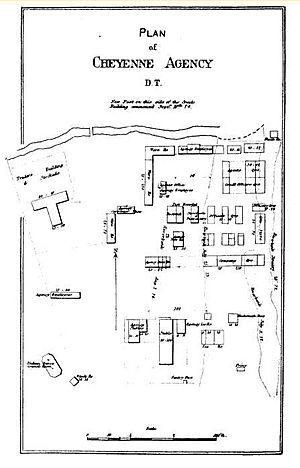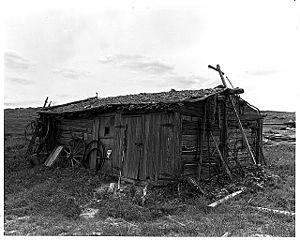Fort Bennett facts for kids
Quick facts for kids Fort Bennett |
|
|---|---|
| was located in Stanley County, South Dakota at the mouth of the Cheyenne River. The site lies under the waters of Oahe Reservoir. | |
| Lua error in Module:Location_map at line 420: attempt to index field 'wikibase' (a nil value). | |
| Site information | |
| Controlled by | United States |
| Site history | |
| Built | 1870 |
| In use | 1870-1891 |
| Battles/wars | Indian Wars |
| Garrison information | |
| Past commanders |
Major Robert E.A. Crofton, 17th Infantry
Captain Edward P. Pearson, 17th Infantry Capt. Carlisle Boyd, 17th Infantry Capt. John H. Donovan, 17th Infantry Lt. Col. George P. Buell, 11th Infantry Colonel William H. Wood, 11th Infantry Captain Charles A. Wikoff, Company E, 11th Infantry Captain William N. Sage, Company I, 11th Infantry Captain Joseph H. Hurst, Company A, 12th Infantry |
| Garrison | 17th U.S. Infantry, Companies B and C
11th U.S. Infantry 12th U.S. Infantry, Companies A and K |
Fort Bennett was a military fort built by the U.S. Army in 1870. It was first known as the Post at Cheyenne River Agency. The fort was set up during a time of conflict called the Indian Wars. Its main purpose was to help manage the Sioux people in the Department of Dakota area. Today, the original site of Fort Bennett is underwater due to the Oahe Dam.
Contents
History of Fort Bennett
Building the Fort
The Cheyenne River Agency was created in 1869. This happened after the Fort Laramie Treaty was signed. This agency was meant for the Two Kettle, Sans Arc, and Miniconjou Sioux tribes.
On May 17, 1870, two companies of soldiers from the 17th U.S. Infantry officially started building the "Post at Cheyenne River Agency." Captain Edward P. Pearson led these soldiers. The fort was built right next to the agency. It was about 7 miles away from Fort Sully. The goal was to provide military protection for the agency.
Key Events at the Fort
Some of the Cheyenne River Indians took part in the Great Sioux War of 1876-77. After the fighting ended, they returned to the agency.
On December 30, 1878, the fort's name was changed to Fort Bennett. This was done to honor Captain Andrew S. Bennett. He was a soldier from the 5th Infantry. Captain Bennett was killed in a battle with the Bannock Indians in Montana Territory.
Fort Bennett was also involved in events during the Ghost Dance uprising of 1890. This was a time of tension and conflict.
Closing the Fort
In 1891, the Great Sioux Reservation was made smaller and divided. After a treaty was approved in 1889, the fort was no longer needed. The Cheyenne River Agency then moved about 56 miles north along the Missouri River. It moved to a spot across from Forest City, Potter County, South Dakota. Later, because of the Oahe Dam being built, the agency moved again to Eagle Butte, South Dakota.
Fort Bennett's Design
Fort Bennett was built along the Missouri River. It was 7 miles north of Fort Sully in Dakota Territory. The fort was about 302 miles from Sioux City, Iowa, by wagon road. It was about 500 miles by river.
Buildings at the Fort
The fort had several military buildings. These included living quarters for two companies of soldiers. There were also officers' quarters and a hospital. Other buildings included a guard house, two block houses, and three storehouses. There was also a bake house, a stable, and workshops. Most of the buildings were made from cottonwood logs. One storehouse was made of wood frames.
Supplies and Resources
Supplies for the fort came from different places. These included Sioux City, Iowa; Yankton, Dakota; Chicago, Illinois; and Jeffersonville, Indiana. Goods were sent by train to Sioux City. From there, they traveled by boat on the Missouri River.
Hay for animals was bought from nearby farms. Wood for fires was also bought through contracts. Water for the fort came from the Missouri River. It was carried to the fort using wagons. The fort usually kept enough food and supplies for 12 months.
Native American Population
The Native American groups at this agency were the Minneconjou, Sans Arc, and Two Kettle tribes of Sioux. About 1,500 people lived at the agency or nearby most of the time. However, the number of people present could change a lot. Sometimes, as many as 7,000 people were at the agency, especially in 1869 and 1870. Many of the Native Americans who belonged to this agency would often travel. They sometimes associated with other groups. The Native Americans who received food rations all year were generally peaceful. However, some of the younger men were not always reliable.



